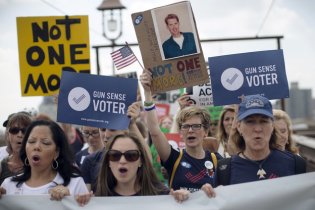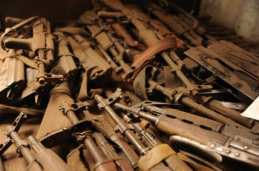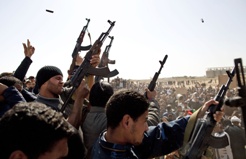 I walked across the Brooklyn Bridge today with members of Moms Demand Action who are working to raise awareness for “common-sense” gun legislation. Ironically, since the vast majority of Americans agree with them, one wonders why the issue still needs that much effort. Yet, here they were, nearly 600 strong – growing in numbers from previous events I have attended – and clearer than ever in their message. From their speeches, I concluded that their primary take on the crisis is to demand legislative action. Yet I came away wondering if that’s the right approach.
I walked across the Brooklyn Bridge today with members of Moms Demand Action who are working to raise awareness for “common-sense” gun legislation. Ironically, since the vast majority of Americans agree with them, one wonders why the issue still needs that much effort. Yet, here they were, nearly 600 strong – growing in numbers from previous events I have attended – and clearer than ever in their message. From their speeches, I concluded that their primary take on the crisis is to demand legislative action. Yet I came away wondering if that’s the right approach.
When I first got involved in this subject, after Sandy Hook as so many of us did, I came to it with no skin in the game. I had not lost anyone to gun violence nor had I been shot myself. I just had a crushing feeling that this was a big issue for our common life together as Americans and that I needed to know more. And after extensive research, I put my journey of inquiry into a book, Unsafe In Human Hands.
My principle conclusion was this: you are more in danger from the gun in your own home than the gun of an intruder. That’s because the person most likely to shoot you in your lifetime you already know. The vast majority of all persons shot have a relationship with the shooter. Here are just three sample statistics;
- Homes with guns are 12 times more likely to have household members or guests killed or injured by their own weapon than by an intruder’s weapon. (Southern Medical Journal in 2010)
- There is a three-fold greater risk of homicide and a five-fold greater risk of suicide for residents in homes with firearms versus homes without firearms (American Journal of Epidemiology)( Johns Hopkins Bloomberg School of Public Health, 2004)
- In 72% of unintentional deaths and injuries, suicide, and suicide attempts with a firearm of 0-19 year-olds, the firearm was stored in the residence of the victim, a relative, or a friend (Harborview Injury Prevention and Research Center Study, Archives of Pediatric and Adolescent Medicine, August 1999)
Yet the majority of gun owners believe the opposite, that a gun in the home provides increased personal safety – presumably against some outside force. In a Washington Post/ABC poll last April, 75% of those who lived in households with guns thought the presence of those guns made it a safer place to be. This result was higher among largely white and conservative men living in the south, and less among women and more liberal populations in the West and Northeast. Among all adults, the question of safety was split almost evenly (51/49). I must confess that after reading so much research to the contrary, I am amazed that we are still on the fence about this.
This begs the question of best strategy; do we try to enforce change through largely hostile legislative action or do we try to win hearts and minds through education using a public health model? You can clearly guess my preference. And I’m pleased to report, we are already making inroads. The General Social Survey, a biannual public opinion survey, has shown a steady drop in gun ownership rates for decades. This move away from gun ownership can reflect a lot of things, from the increasing urbanization of America (people in cities tend to own less guns) to a general reduction in violent crime. But it might also indicate that attitudes are changing too. It’s a general maxim in consumer research that you get a more accurate tell on what consumers do rather than what they say. So if people are already moving in this direction, maybe their attitudes are in flux and all we need is a nudge, rather than a body blow.
Some states are taking initiatives that are notable. Washington State’s Department of Social and Health Services, for example, does a particularly nice job with a short document on Gun Safety for Families (http://www.dshs.wa.gov/pdf/ca/gunsafe.pdf). It highlights the need for locking up guns and keeping them away from young people. By my own calculations, if all guns in homes were locked up and the access was restricted to those between 25 and 70 years old (thereby protecting the two most vulnerable age groups; young and elderly), we would save about 10,000 lives per year! Yet according to a Rand Corporation study, of families in the United States with children and firearms, fewer than half store their firearms unloaded, locked, and away from ammunition. Again, there is a perception gap – most gun owners, when surveyed, have the perception that an unloaded gun is useless in an emergency.
I don’t believe imposing legislation alone will change this perception. Yet I’m willing to admit exceptions – especially with background checks. For example, according to the FBI, in states where a background check is required for every handgun sale, 38 percent fewer women are shot and killed by abusive partners. And in states that require background checks for private handgun sales, 39 percent fewer law enforcement officers are shot to death with handguns. So OK, maybe a mix of legislation and education.
Either way, I think change will come mostly through the women in this country. That’s why I am so pleased to hang with Mom’s Demand Action. They and their children are the most vulnerable. Certainly, the statistics regarding guns in homes as they affect women are chilling.
- the risk of homicide against women goes up 5 times when a gun is present in domestic violence situations (American Journal of Public Health, 2003)
- 64 percent of women murdered with guns were killed by a current or former intimate partner (FBI, 2010)
- the number of women shot and killed by partners was six times higher than the number killed by strangers using all other weapons combined. (Violence Policy Center reports that in 2010).
 So here I was with this group of women, highly mobilized and determined to bring a public health problem to our attention – one that kills more than 30,000 Americans a year. And I think they’re wonderful. I just ask that they add to their focus a more public health and education approach. There are existing models available to follow, such as the one we used to teach that smoking causes cancer or the battle to get seat belts adopted or MADD’s efforts to combat drunken driving. We can persuade as well as force and I believe we will ultimately secure more permanent change with an educated and informed public than a legislatively restricted one.
So here I was with this group of women, highly mobilized and determined to bring a public health problem to our attention – one that kills more than 30,000 Americans a year. And I think they’re wonderful. I just ask that they add to their focus a more public health and education approach. There are existing models available to follow, such as the one we used to teach that smoking causes cancer or the battle to get seat belts adopted or MADD’s efforts to combat drunken driving. We can persuade as well as force and I believe we will ultimately secure more permanent change with an educated and informed public than a legislatively restricted one.
Christopher L. Johnson is the author of Unsafe In Human Hands, which tries to contribute to the debate on violence and gun ownership in America both by dispelling myths and by sharing real research on a human level. We need to inform the gun owning public of the risks these things pose to their families so that they can make the best choices possible. 100% of the Author’s proceeds are donated to Cure Violence, Chicago

 We, the American family, have a problem. By our own hands, we kill as many of our own kind every month as the hijackers did just once back on 9/11. That’s thousands every single month! And the vast majority of these deaths come at the hands of family, friends, neighbors and coworkers. Not strangers. As Pogo once said, we have met the enemy and he is us.
We, the American family, have a problem. By our own hands, we kill as many of our own kind every month as the hijackers did just once back on 9/11. That’s thousands every single month! And the vast majority of these deaths come at the hands of family, friends, neighbors and coworkers. Not strangers. As Pogo once said, we have met the enemy and he is us.
